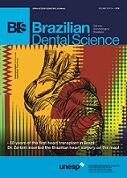Effect of glide path on transportation promoted by NiTi and M-Wire instruments
DOI:
https://doi.org/10.14295/bds.2018.v21i1.1525Abstract
Objective: To evaluate the effect of glide path creation on transportation promoted by NiTi and M-Wire instruments. Material and Methods: Sixty polyester resin blocks containing a simulated root canal were distributed into four groups (n=15), according to the protocols/systems used for root canal preparation: GPR group - glide path + Revo-S system; R group - no glide path + Revo-S system; GPPN group - glide path + ProTaper Next system and PN group - no glide path + ProTaper Next system. Root canals were photographed before and after preparation, and the images were superimposed to evaluate the transportation at the apical, middle and coronal thirds. The time spent to perform preparation was also measured (seconds). Data were submitted to the non-parametric Kruskal-Wallis test (p<0.05) for statistical analysis. Results: In the apical third, there was no significant difference among groups (p>0.05). GPR and R groups were similar in the middle third (p>0.05). However, the transportation value in GPR group was statistically higher in comparison with GPPN and PN groups (p<0.05). In the coronal third, GPR and R groups were similar (p>0.05). Only R group presented significant difference in comparison with GPPN and PN groups (p<0.05). There was no difference among groups about time spent to perform preparation (p>0.05). Conclusion: None of the systems were capable of maintaining the original trajectory of the simulated root canal, and the glide path had no effect on the transportation promoted by instruments.
Keywords
Dental instruments; Endodontics; Root canal preparation.
Downloads
Downloads
Additional Files
Published
How to Cite
Issue
Section
License
Brazilian Dental Science uses the Creative Commons (CC-BY 4.0) license, thus preserving the integrity of articles in an open access environment. The journal allows the author to retain publishing rights without restrictions.
=================




























